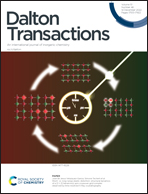Effect of the flexible chain length of a dimetal subunit on the formation of 1D coordination polymers to molecular rectangles†
Abstract
Utilizing the angular and rigid furan dicarboxylate (fdc2−) ion, a new series of four (1–4) metal–organic coordination networks (MOCNs) is synthesized in good yields through a one-pot self-assembly reaction in methanol under ambient conditions to demonstrate the effect of Cu2 dimetal subunits, connected by flexible polypyridyl bis(tridentate) ancillary ligands, tpxn, where x refers to the number of methylene groups connecting the alkyl nitrogen atoms in the ancillary ligands and is equal to 2, 4, 6, and 7. The solid-state molecular structures of 1–4 are determined by single-crystal X-ray diffraction. A change in the dimensionality of the resultant MOCN is observed from a 1D coordination polymer (CP) for 1, 2, and 3 to a molecular rectangle for 4. Furthermore, each unit of 4 contains one NaClO4. Using electrospray ionization (ESI) mass spectrometry, their structural integrity in solution and their purity of existence as a single product are confirmed. Further characterization of 1–4 by FTIR and UV-vis (in solution and solid-state) spectroscopy, and FESEM and TEM is also reported. The presence of unsaturated metal centers in 1–4 provided an opportunity to compare their Lewis acid catalytic activities for the Knoevenagel condensation reaction of malononitrile with various aldehydes.



 Please wait while we load your content...
Please wait while we load your content...